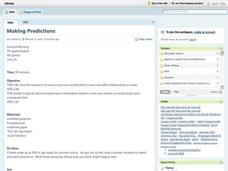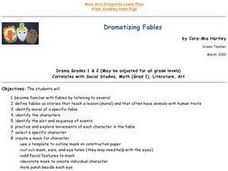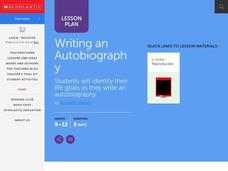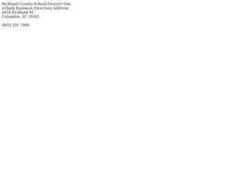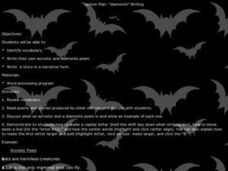Curated OER
Is There Room on the Bus?
Students explore beginning, middle, and end by listening to a story and completing a worksheet. They retell the story referring to the sequencing of events.
Curated OER
Making Predictions
Seventh graders read stories, stopping periodically to make predictions. They discuss how the sequence of events, as well as cause and effect, can give hints to the outcome of the story. In addition, 7th graders use logic and...
Curated OER
Dramatizing Fables
Students familiarize themselves with fables by listening to several of them. They define fables. They identify the moral of a specific fable. They identify characters, plot and sequence of events. They create a mask of a character in a...
Curated OER
Great Expectations: Group Writing
Examine the differences between totalitarianism and democracy in this writing lesson plan. Using the same format and theme from Great Expectations, young writers work in pairs to compose their own short stories. They follow guidelines...
Curated OER
Flying Freudian Fun: A Look At Ethical Decision Making
There are not many more apt examples of ethics gone awry than William Golding's Lord of the Flies.. Ninth graders focus the ethics of decision making with the examples provided in the plot. They focus on the concept of the psyche and how...
Curated OER
“THE LORAX” by Dr. Seuss
Few children's books convey the message of conservation as well as Dr. Seuss' The Lorax. Read the story aloud, emphasizing the interconnectedness of plants and animals in an ecosystem and discussing different ways people can help the...
Curated OER
Writing an Autobiography
Students identify life goals as they write an autobiography. They write a strong introduction for their autobiography. Students write a sequences of events using their Life Map as a graphic organizer. They write facts accurately...
Student Handouts
Process Steps
A straightforward graphic organizer is a great way to outline steps for any subject. Kids fill out 10 steps to describe a process or brainstorm writing, with small arrows indicating that one step leads to the next.
Curated OER
Amos and Boris: Text Study
Twenty insightful questions follow a read aloud of the story, Amos and Boris by William Steig. Scholars then show what they know through completion of a cause and effect chart, reading fluency assessment, and a written explanatory or...
Midland Independent School District
Drama
Ten drama lessons are the perfect addition to your language arts or theater class. With a focus on script elements, plot development, and parts of a dramatic story, the lessons guide young playwrights through the steps of telling a story...
Curated OER
Practice: Word Problems
Congratulations, you've just hit the word problem jackpot! Covering an incredible range of topics from integers and fractions, to percents, geometry, and much more, this collection of worksheets will keep young mathematicians busy...
Curated OER
Using Sequencing As A Reading Strategy
Sequencing is an important reading strategy students can use to unlock the meaning of a text.
Curated OER
Animal Diaries
Learners read Diary of a Worm by Foreen Cronin. In this journal writing lesson, students research an animal and write a diary by their animal. Learners apply the research they've completed in their writings. Students share their diaries....
Curated OER
Comprehension Through The Very Hungry Caterpillar
Young scholars sequence seven events from "The Very Hungry Caterpillar" by matching the correct event with the day of the week. They recall details from the story as they unscramble words on a worksheet.
Curated OER
The Very Hungry Caterpillar
First graders, after reading The Very Hungry Caterpillar, place the story in its correct order of sequence. They place any set of events (situation) in their correct order.
Curated OER
Newscast From An Ancient City
Seventh graders produce a newscast from an Ancient Roman city. For this journalism and history lesson, 7th graders work in groups to dramatize a historical event from the Roman Empire. students sequence the events, role-play, and create...
Curated OER
Writing Application: The Canterbury Tales
Students read stories from The Canterbury Tales by Geoffrey Chaucer and create their own tale. In this writing applications lesson plan, students read the tales and analyze the specific details that Chaucer use. Students work in groups...
Curated OER
Kama's Lei
Pupils read a book entitled "Kama's Lei" and "El Lei De Kama." They discuss the meaning of the word "lei" and predict what may happen int he story. Students explore strategies for decoding unfamiliar words. They explore the sequence of...
Curated OER
Map the Path in My Father's Dragon
Students listen to Ruth Stiles Gannett's book My Father's Dragon. They predict the outcome of the story. They discuss the events in the story. They sequence the events in the story.
Curated OER
Pop Pop And Grandpa
Students develop various skills needed to perform the best examples of reading comprehension for the purpose increasing literacy. They make cognitive connections to the sequence of events in the story and make comparisons as events occur.
Curated OER
Diamonte Writing
Students discover poetry while practicing their storytelling skills. For this language arts lesson, students read diamonte and acrostic poems written by other students on the Internet. Students create their own narrative stories about...
Curated OER
Tell a Tale
Students create a class story using picture cards. Each student picks a card, tapes it to the board, and retells the story in sequential order using the words then and next.
Curated OER
Silly Sally
Students examine character traits. In this literary elements lesson, students read 2 short stories paying special attention to the actions and descriptions of the characters. Students add themselves as characters in the story.
Curated OER
Hero and Heroine Activity
In this heroes and heroines learning exercise, students list qualities and write a story about a heroic action of a person who has "touched their life." Students also illustrate a story moment or sequence of events.



